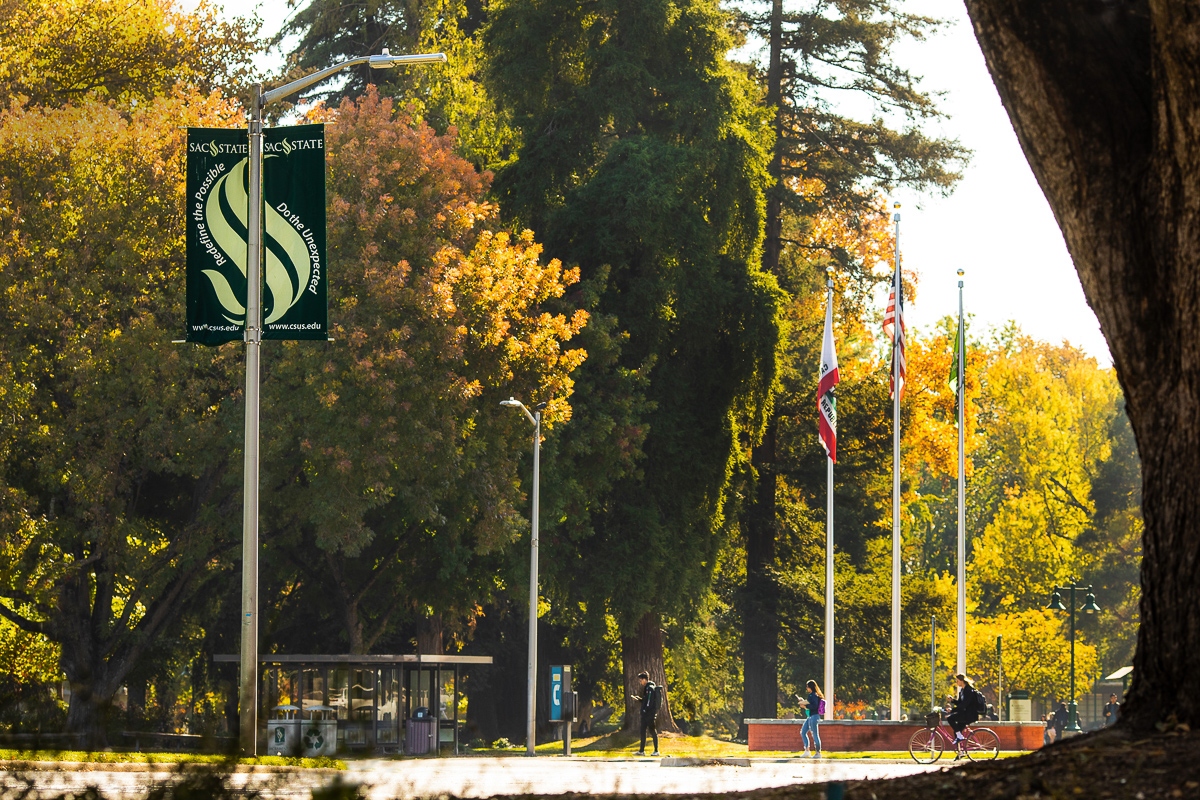
By Dixie Reid
Sacramento State’s celebrated urban forest is more than simply majestic shade trees spread across a lush, 300-acre landscape.
Those 3,714 trees, the oldest planted nearly seven decades ago, are essential to a healthy natural environment and illustrate Sac State’s commitment to sustainability.
Each year, the trees remove 1.7 tons of pollution from the air, store more than 3,000 tons of harmful carbon, and produce 237 tons of oxygen.
“Planting a tree is a gift for the future,” said Erik Skall, the University’s grounds manager. “Now more than ever, proper tree-planting and management are crucial to ensuring the health of our planet and ourselves. I’m truly honored to witness Sac State meeting this challenge.”
The University will celebrate its growing urban forest with a special ceremony Thursday, Sept. 24, that will serve as Sac State’s Arbor Day 2020 observation, which was postponed from April because of the COVID-19 pandemic.
“The newly planted trees continue the enduring tree legacy of the campus and will broaden the urban forest for future generations of Hornets.”
With a $123,000 Cool Parks grant from the California Urban Forests Council, through CalFire, Sac State’s urban forest has grown by 250 trees since the campus closed in March because of the pandemic. Many can be found along College Town Drive, and in Parking Lots 7 and 8.
“We are honored to receive the Cool Parks grant,” said Jonathan Bowman, vice president for Administration and Business Affairs. “The newly planted trees continue the enduring tree legacy of the campus and will broaden the urban forest for future generations of Hornets.”
Speakers at the ceremony, which begins at 10 a.m., are expected to include Bowman and representatives of the Sacramento Tree Foundation and West Coast Arborists.
In Sac State’s original Arbor Day plans, students were to plant trees as a part of Alternative Spring Break, a program of the Community Engagement Center. But by then distance learning was well underway and few people remained on campus.
Instead, the work was done by West Coast Arborists (WCA), which provides the University professional tree maintenance and management services. WCA’s specialists removed dozens of dead, dying, and hazardous trees on campus, making way for the new saplings.
The new plantings, including Chinese pistache, valley oaks, camphor, and southern live oak, are resistant to drought, pests, and disease.
Sac State’s tree legacy dates to years before state legislators bought the land at 6000 J St. as the future site of then-Sacramento State College. Much of the acreage was a peach orchard and hops fields.
Tree planting began almost immediately after the orchard and hops were leveled in 1952. Grounds crews would come to work in the morning to find that pesky jackrabbits had nibbled the tender saplings down to the ground at night. So they replanted, again and again, until the trees grew and took root.
In 2012, Sac State met the high standards of the Arbor Day Foundation and became only the sixth university in California to be named a Tree Campus USA. The national program recognizes colleges and universities that promote healthy trees and engage their students and staff in conservation.
Sacramento State has been honored as a Tree Campus every year since.
In June, the National Wildlife Federation certified Sacramento State as a Garden for Wildlife. It’s the largest and longest-running movement dedicated to helping wildlife and preserving wild spaces. The idea is for a community to build a sustainable environment that offers food, water, and shelter from predators, and a safe place for all to raise their young.
Among the most dominant tree species enjoyed by the campus community and resident wildlife are Canary Island pine, Chinese pistache, sequoia sempervirens (coast redwood), and eucalyptus globulus.
Approximately 43% of Sac State’s trees are native to North America, and 21% are California natives. Most of the non-native, exotic species are Asian.